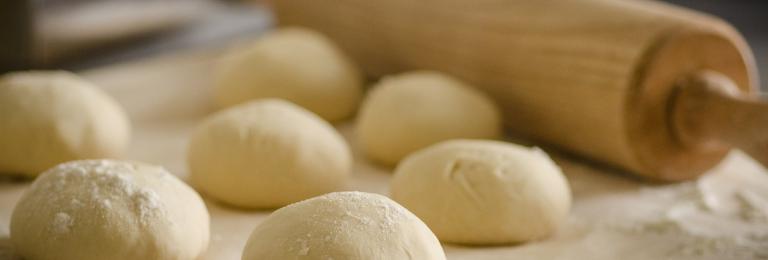Pizza Pizzazz
This activity is good for developing imagination, learning about where food comes from, and practicing meal-time conversation.
Pizza can be a healthy meal because it includes all food groups. Children are more likely to try fruits and vegetables if they have a chance to learn about them in a fun way.
main activity:
- Play “pizza making” with your child. Let your child lead the pretend play.
- Choose who will make the dough and who will prepare the toppings. Talk about what kind of pizza you want to eat and who will be making it.
- Pretend to eat pizza together. Sit down and enjoy a conversation while you eat.
You can say, and ask questions like:
“Let’s play pizza making! Who will make the dough and who will prepare the toppings?”
“I like mushrooms on my pizza. What do you like on your pizza?”
Here are some more tips for this activity:
Get down to your child’s level when you pretend together. Sit down so you can have a conversation eye-to-eye.
Help your child lead the pretend play by asking questions that encourage imagination, e.g. “What do we use to make sauce? Where does cheese come from?”
Add some props, e.g. a rolling pin and cookie sheet. Make pizza menus with pictures of foods that go on pizzas.
Make individual pizzas using different breads as bases, e.g., English muffins, pitas, bagels, roti, bannock, or tortillas.
Encourage your child to choose her own toppings.
For special days, make pizza treats, or try some of these ideas:
- Create “Cookie Cutter pizzas”: for Halloween cut pita bread or English muffins with a jack-o-lantern cookie cutter. Add peppers, mushrooms and ham or turkey cut into shapes for eyes, nose and mouth.
- Create “Holiday Pizzas”: with dough shaped into a heart for Valentine’s Day or an evergreen tree for a winter celebration.
- Create “Fruit Pizzas” too: use biscuit dough as a base, yogurt for “sauce” and slices of apple, banana, pineapple chunks, and other fruits as toppings. Sprinkle with cinnamon.
A good read-together book: Pizza at Sally’s by Monica Wellington
Safety Tips
- Help your child to wash her hands with soap and water before and after preparing food.
- Supervise your child when using knives or other kitchen utensils.
- For active play, make sure the area is clear of obstacles before playing.
Additional Links:
The following link on the Better Together BC website discusses what tasks young children and older children can do: https://www.bettertogetherbc.ca/learn/tips/cooking-is-a-family-affair1
Source: LEAP BC (www.leapbc.decoda.ca)
